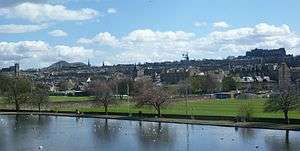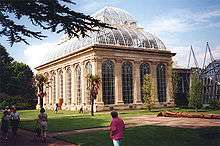Inverleith
Inverleith (Scottish Gaelic: Inbhir Lìte) is an inner suburb in the north of Edinburgh, Scotland, on the fringes of the central region of the city. Its neighbours include Trinity to the north and the New Town to the south, with Canonmills at the south-east and Stockbridge at the south-west. Like a great many places in and around Lothian and Edinburgh, the name comes from Scottish Gaelic – Inbhir Lìte, meaning "Mouth of Leith", as with Inverness, meaning mouth of the River Ness. Some documents refer to the area as "Inner Leith".

It is characterised by its wealth of open green space. The Royal Botanic Garden Edinburgh and Inverleith Park, in addition to the numerous playing fields owned and used by the independent schools Edinburgh Academy, Fettes College, Stewart's Melville College and George Heriot's. The Royal Botanic Gardens' nursery garden, for growing and cultivating plants, is also located here. Within Inverleith, there are very few shops and offices, and it is almost entirely a residential and recreational area.

Today Inverleith is home to houses often being sold considerably in excess of one million pounds sterling.[2] These include Scotland's most expensive penthouses, selling for £1.5m, and a recently renovated villa, which sold for over two million pounds sterling.[3] The houses are generally handsome and spacious Victorian or Georgian villas with two or three floors, garages and quite large gardens. The residents tend to be employed in professions in central Edinburgh. It is convenient for such workers, as it lies only a mile and a half from the centre. Being on grounds slightly higher than the centre, it commands views of the Edinburgh skyline, including Edinburgh Castle and Arthur's Seat. It has one of the lowest crime rates in the city.[4]
Within the area are Fettes College, an independent boarding school where former British prime minister Tony Blair was educated, and the state-run Broughton High School. Edinburgh Academy, an independent day school where the previous British Lord Chancellor Lord Falconer was educated, is located nearby in the north of the New Town.
Early proprietors
Inverleith was for over two centuries owned by the Rocheid (sometimes spelt Rochead) family. It changed hands when a co-heiress, Mary (d. 1749) married Sir Francis Kinloch, 3rd Baronet, of Gilmerton (1676–1747).[5] Their son Alexander (d. 1755) inherited the entire Inverleith estates, and changed his surname to become Alexander Rocheid of Inverleith. Alexander and his descendants spent most of their time in Germany, and the Inverleith estate was leased. In 1774, Inverleith House was built, to designs by the architect David Henderson.[6] Alexander's son James Rocheid of Inverleith leased Inverleith Mains at the beginning of the 19th century to George Lauder (1776–1824), Comptroller of the City of Edinburgh's Tolls, and the great-grandfather of Sir Harry Lauder.[7]
Parks and gardens

In late 1823, George Lauder, described as the tenant farmer of Inverleith Mains,[8] agreed with James Rocheid of Inverleith to a reversion of part of his leasehold lands, 11.5 Scots acres, for the site of the Royal Botanic Garden, which had formerly been located on Leith Walk. Commonly known as "The Botanics", the new site was opened in May 1824, comprising a large and varied set of gardens or parks with a wide range of plants, from around the world, in the open and in greenhouses. There is a Chinese-themed garden, an extensive landscaped rock garden, a large palm house, and since its opening in July 2006, an official memorial of Queen Elizabeth The Queen Mother, opened by Queen Elizabeth. It is maintained as a very popular tourist attraction, local leisure amenity, and scientific research centre.
In 1889 the City acquired South Inverleith Mains Farm from the Rocheid family to create Inverleith Park, adjacent to the Royal Botanic Gardens.[9] This includes allotments and a well maintained pond, popular for use by model boat enthusiasts and well populated with water birds and occasionally kingfishers. The park also the site of French boule (pétanque) competitions. Cricket, rugby union and football matches are played there as well. There are also tennis and volleyball courts maintained by Edinburgh Council and a safe play area for toddlers.
The park has hosted the Edinburgh International Science Festival, and is also used as a viewing area for fireworks set off over central Edinburgh. Inverleith Park also plays host to an annual Foodies Festival.
In early 2018, the Kinloch Anderson Sundial that was originally gifted to the City of Edinburgh in 1890, was restored as the result of an approach from the Friends of Inverleith Park to Kinloch Anderson. The company restored the sundial to mark its 150th anniversary.[10]
The park has also played host as a shooting location for feature films such as Chariots of Fire and Dark Sense.[11]
Notable Residents
Rugby
In 1897 land at Inverleith was purchased by the Scottish Rugby Union (then the Scottish Football Union). Thus the organisation became the first of the "Home Unions" to own its own ground.[12] The first visitors were Ireland, on 18 February 1899 when the score was Scotland 3 — Ireland 9. International rugby was played at Inverleith until 1925 when it was transferred to Murrayfield Stadium. The parts of the land at Inverleith are now owned by Stewart's Melville College and The Edinburgh Academy. They are used as playing fields for rugby in the winter and cricket/athletics in the summer. The park currently is home to Edinburgh Northern RFC, with home matches taking place on the pitch closest to East Fettes Avenue.
References
- "Edinburgh, 18 Inverleith Terrace, Site Number NT27NW 146". CANMORE. RCAHMS. Retrieved 1 April 2009.
- "House prices in Inverleith Place, Edinburgh EH3 stand at £1,049,244 on average - Zoopla".
- "Archived copy". Archived from the original on 19 February 2014. Retrieved 23 April 2013.CS1 maint: archived copy as title (link)
- "The Strategy for Justice in Scotland: Evidence Paper". 21 September 2012.
- Index to Genealogies, Birthbriefs, and Funeral Escutcheons, recorded in the Lyon Office, by Francis J. Grant, W.S., Lyon Clerk and Keeper of the Records, Edinburgh, 1908, p. 46
- "Inverleith House, Site Number NT27NW 27". CANMORE. RCAHMS. Retrieved 1 April 2009.
- The Ancestry of Sir Harry Lauder, in The Scottish Genealogist, vol. LIII, No.2, Edinburgh, June 2006, pps: 74 - 87. ISSN 0300-337X
- "Biographical Notes on Sir Harry Lauder".
- City of Edinburgh Council: Inverleith Conservation Area Character Appraisal p.8
- "Firm celebrates 150 years by restoring park's sundial - Scottish Field". Scottish Field. 21 June 2018. Retrieved 22 June 2018.
- "Edinburgh Film Map - This is Edinburgh". edinburgh.org. Retrieved 22 June 2018.
- Staff. "Inverleith: the first purpose-built international rugby ground". www.rugbyfootballhistory.com. www.rugbyfootballhistory.com. Retrieved 3 June 2015.
Bibliography
- The Royal Botanic Garden Edinburgh, by Harold R Fletcher and William H Brown, HMSO, Edinburgh, 1970, ISBN 0-11-490425-1
